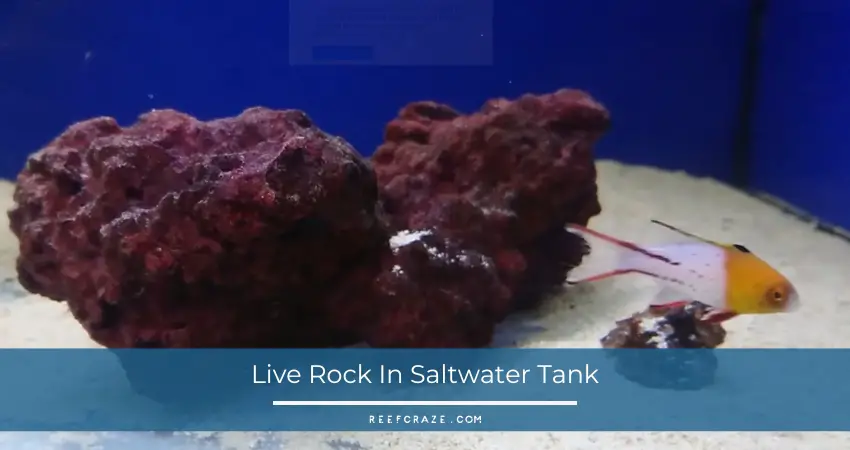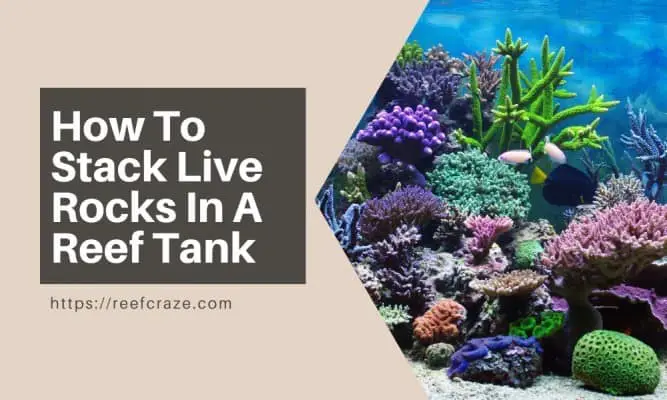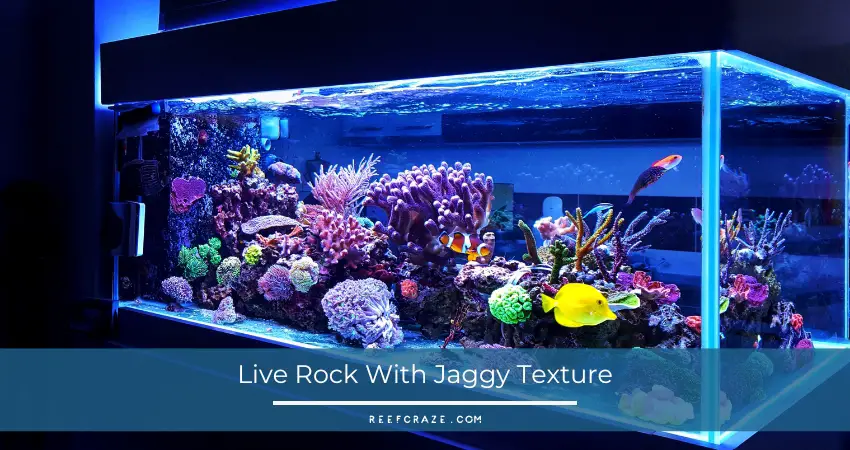The decoration of a reef tank varies from one hobbyist to another. Regardless of which decoration pattern you follow, you should definitely consider using live rocks as a part of it. Live rocks not only enhance the beauty of a reef tank but also provides shelter for the tank inhabitants and works as the biological filter for the tank.
How you will stack the rocks depends a lot on the texture of the rock surface that you have selected. But a general way to go is putting them loosely in the water so that the water can circulate properly around and through the structure. But it cannot be so loose that it becomes unsafe for the rocks to sit tight and makes them topple off easily.
Apart from this, there are other things you have to consider while decorating your reef tank with live rocks. To learn about them, keep scrolling down!
Why Should You Have Live Rocks In Your Reef Tank?

There are a lot of reasons why live rocks make great additions to your reef tank.
First, they enhance the beauty of your tank to a great extent. Imagine a reef tank with an empty bottom having a dull view. That would look a little boring, right?
Secondly, it shelters the tank inhabitants and gives them protection from other aggressive tank mates.
Thirdly, while adding an aesthetic vibe to the tank environment, it works as a house for the fish and other animals. A cave made of the rocks makes them feel safer and more secure in the tank. This has a very positive impact on their health.
Fourthly, live rocks give the animals their own territory to defend. When each of them has their own place, they do not fight for the entire tank. This helps to mitigate their aggression. It is very important if you own a community tank or if your tank houses more than one male of a particular species.
Lastly and MOST IMPORTANTLY, live rocks serve as the main base for biological nitrification (or biological filter) for a reef tank. Live rocks carry different kinds of algae, corals, and bacteria. This consequently has some effects on the wastes of the water like nitrate, phosphate, and ammonia. They instantly consume the waste products and help to keep the water quality stable.
When associated with the live rocks, bacteria can convert ammonia into nitrate. And the algae and the corals can absorb that nitrate. Besides, the bacteria, in the vicinity of the other bacteria producing nitrate, can also remove that nitrate.
So, while you are asking why you would want to have live rocks in your reef tank, let me ask you now, why would you not want to have them?

How Do You Stack The Rocks?
Before you start stacking the live rocks in your aquarium, hold on a second. How you will stack them depends highly on the texture of the shape you have chosen. For example, the rock texture can be either smooth or jagged. Let’s see how stacking varies from one rock texture to another.
Smooth Texture
If the rocks you chose are smooth, then there are two decoration options for you.
The first one is to keep the stack short. It will look like a pile of small rubble. It will serve its purpose as a decoration piece only because the space between the rocks are too small to let the fish hide.

You can do either that or glue the rock pieces together with silicone, and this is your second option. Remember that once you have glued them together, they will remain stuck like that. The same look of the tank might even bore you someday.
Bringing changes by restructuring the rock formation can give your tank different looks. But you lose that chance when you use the second option.
Jaggy Texture
In case you have jagged rocks, then stacking will become much easier for you. First, make a wide base with the rocks that is firmly set in the substrate. Then, make layers by adding more rocks. Remember to keep them stable. Otherwise, the tank fish will bump into the rocks and break their layers.

You can try putting a rock in a particular place and then pushing it in every direction. If the rock shifts, change the place. It may take you some time, but it will be worth it when you can form a perfectly stable wall in the end. Like a puzzle, the jaggy edges will let you fit all the things together.
As you make your way up, you will need to taper the live rocks so that the upper part of the stack gradually becomes narrower and does not lean against the tank’s back glass. It is also important that the size of the caves made of the rocks matches the size of the fish you keep in your tank.
This is because the purpose of making the cave is allowing the fish to take shelter in it. It will give the fish a more natural environment. If the space between the rocks is too small or too large for the fish, they will avoid the caves. And the caves will be there for nothing.
Related Article: Dry Rock vs. Live Rock
How Do You Make Sure The Rocks Will Not Break The Glass?
Now that is a serious issue. If you cannot position the rocks appropriately, they may topple and break the glass anytime causing a great mishap in the reef tank. So, what can you do to make sure the rocks do not cause any accident?
Well, there are 3 ways for you. Strictly follow all of them to protect your tank.
Not Putting Too Much Weight:
Keep in mind that your aquarium cannot hold more rock weight than it is capable of. It has a limit.
Many hobbyists calculate how much of rock weight they will put in the tank on the basis of the tank water. If the tank has 55 gallons of water, they will use twice as many rocks (that makes it 110 lbs.) in their tank. So, the weight is basically the double amount of the water.
This is like a general rule for tank owners. It allows them to have a lot of rocks to make big stacks, and it causes no weight problems for their tanks.
Not Making Pressure Points:
You do not want a piece of rock lying on the back glass, particularly if there are more rocks creating more pressure on that piece of rock. Whenever you have points against that part of glass, it is very much possible that the pressure will break the glass.
This means you should stack the rocks in a way so that the rocks do not have to rest on the glass. This is the safest way to protect it.
You also have to make sure that there is a substrate layer between the rock and the bottom glass. If you push on the bottom layer a lot, you will move the substrate out of its way. Then the rocks have points that will hit the bottom glass. This is undoubtedly bad for the tank.
If you decide to have a good amount of rocks in your tank, then it is mandatory that you make a thick substrate layer that will be able to disperse the rock weight.
Keeping The Rocks Stable:
As I told you earlier, the tank fish can easily dig out the substrate layer and bump into the rocks. To make sure it cannot break the caves and rocks, you have to keep them strong, stable, and secure.
If the weight issue bothers you too much, you can buy an egg crate from any local hardware store and place it under the substrate layer. It will help to disperse the rock weight. But it can be a real pain when you have to deep vacuum the substrate.
How Do You Take Care Of The Live Rocks?
You have to take care of the rocks regularly. Their presence in the tank may make it hard for you to catch the fish. That means you have to take some of the rocks (if not all) out of the tank to catch your tank fish. That requires both your time and effort equally.
Another important thing is that waste and uneaten food can get into the rock cracks and will accumulate in the substrate layer. You have to take all the rocks out and clean the substrate monthly or bimonthly.
You will have to carry out these maintenance tasks regardless of the tank decoration. So, do not let the fact that you would have to work less if you used fewer or no rocks get into you and stop you from decorating your reef tank.
Any Suggestions For Decoration?
Yes! I can give you some very helpful suggestions for your tank decoration. Let’s have a look at them!
- If you decide to decorate your reef tank with live rocks but do not want to have your tank cluttered with them, choose the rocks carefully. It is better if you stack one or two pieces of large rocks in specific areas in the tank instead of making large piles with middle or small sized rocks.
- Do not leave any rock leaning against the back glass of your tank. And do not use any rock that takes up a lot of space in the tank. Because that will limit your fish’s swimming abilities. Besides, it will not serve the purpose of making the tank environment natural.
- If you want to add a little more to the natural appearance of your reef tank, try to put some live plant among the rocks in the tank.
Final Words
This is basically all you need to know about stacking live rocks in a reef tank. It is not that complex. You just have to put them in the right way and ensure that they remain there stably.
How you decide to decorate your reef tank is totally up to you. Because ultimately you are the only one that is supposed to be pleased with the way the reef tank looks.
Again, while everything is your choice, you should remember and consider everything covered in this article before decorating your tank. That will help you avoid certain problems like the rocks breaking the glass or your fish bumping into them and causing them to break.
Once you are done with it, you will see that the amazing appearance of your tank was completely worth it. It will also make a positive change for your tank fish.
So, good luck with your reef tank decoration!
